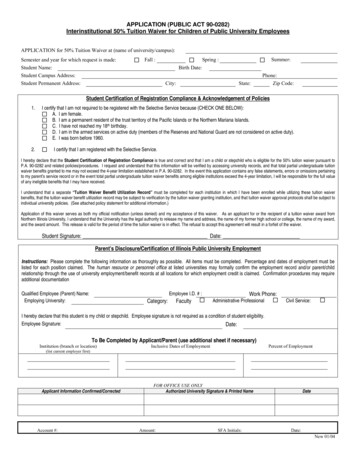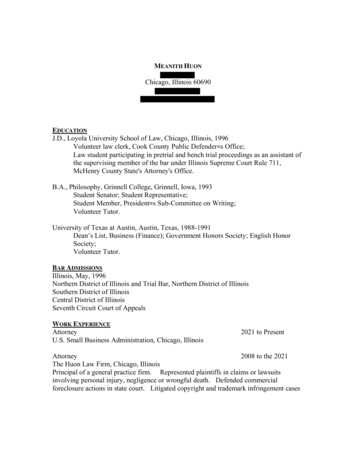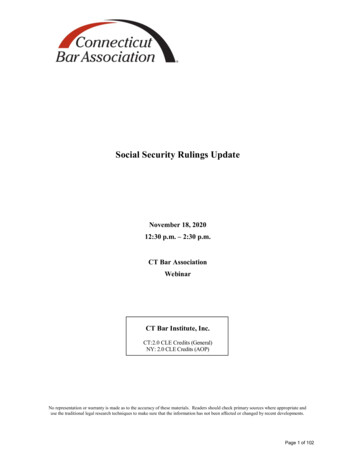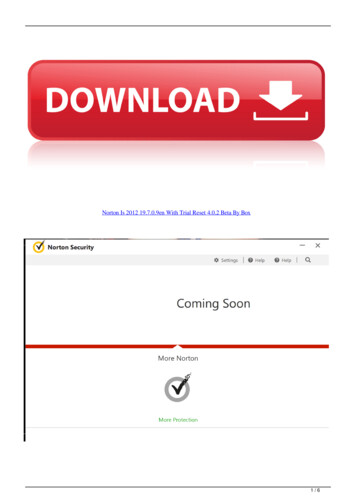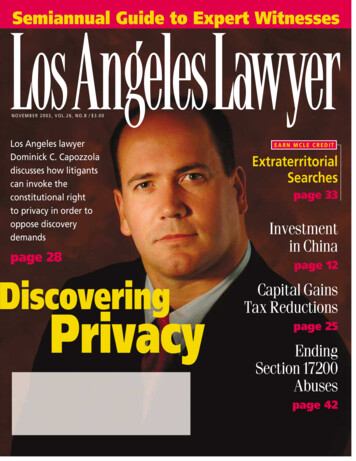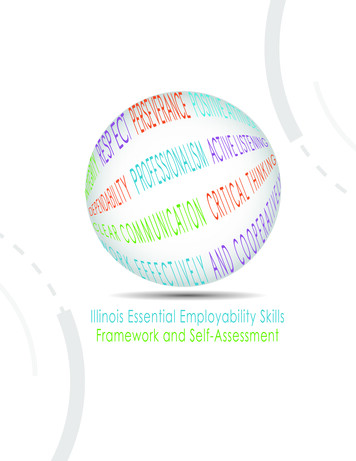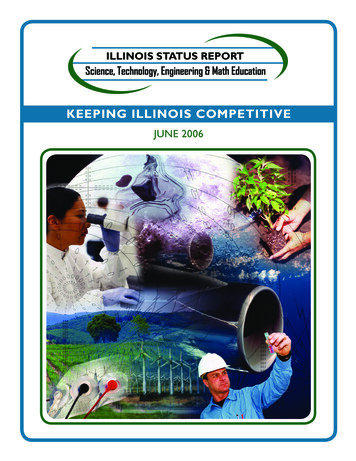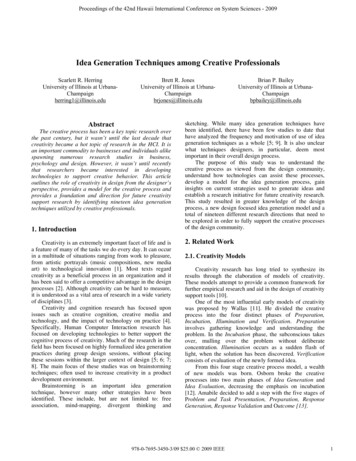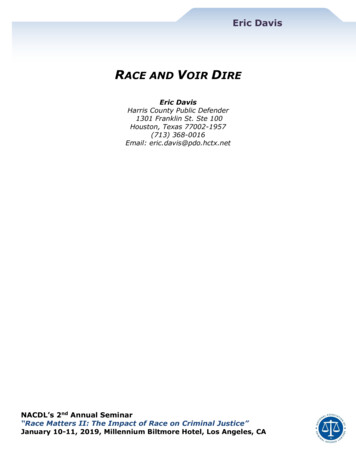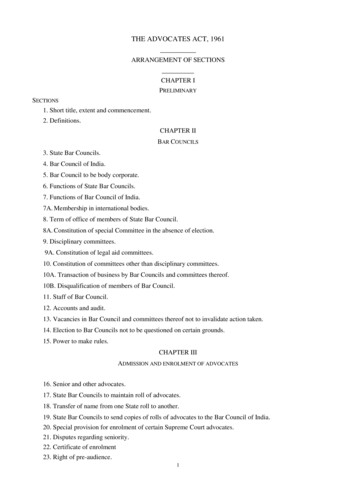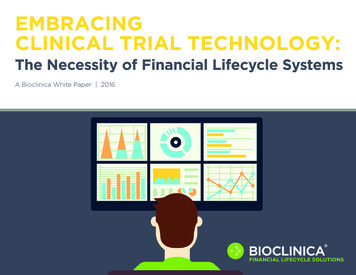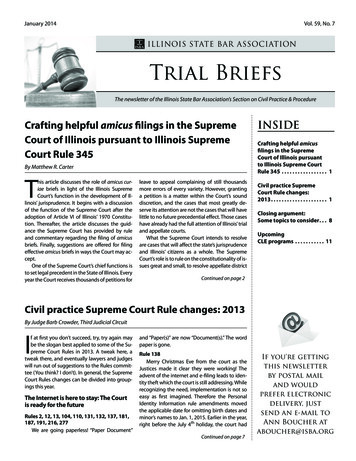
Transcription
January 2014Vol. 59, No. 7Illinois State Bar AssociationTrial BriefsThe newsletter of the Illinois State Bar Association’s Section on Civil Practice & ProcedureCrafting helpful amicus filings in the SupremeCourt of Illinois pursuant to Illinois SupremeCourt Rule 345By Matthew R. CarterThis article discusses the role of amicus curiae briefs in light of the Illinois SupremeCourt’s function in the development of Illinois’ jurisprudence. It begins with a discussionof the function of the Supreme Court after theadoption of Article VI of Illinois’ 1970 Constitution. Thereafter, the article discusses the guidance the Supreme Court has provided by ruleand commentary regarding the filing of amicusbriefs. Finally, suggestions are offered for filingeffective amicus briefs in ways the Court may accept.One of the Supreme Court’s chief functions isto set legal precedent in the State of Illinois. Everyyear the Court receives thousands of petitions forleave to appeal complaining of still thousandsmore errors of every variety. However, grantinga petition is a matter within the Court’s sounddiscretion, and the cases that most greatly deserve its attention are not the cases that will havelittle to no future precedential effect. Those caseshave already had the full attention of Illinois’ trialand appellate courts.What the Supreme Court intends to resolveare cases that will affect the state’s jurisprudenceand Illinois’ citizens as a whole. The SupremeCourt’s role is to rule on the constitutionality of issues great and small, to resolve appellate districtInsideCrafting helpful amicusfilings in the SupremeCourt of Illinois pursuantto Illinois Supreme CourtRule 345 . . . . . . . . . . . . . . . . . . 1Civil practice SupremeCourt Rule changes:2013. . . . . . . . . . . . . . . . . . . . . . 1Closing argument:Some topics to consider. . . . 8UpcomingCLE programs . . . . . . . . . . . . 11Continued on page 2Civil practice Supreme Court Rule changes: 2013By Judge Barb Crowder, Third Judicial CIrcuitIf at first you don’t succeed, try, try again maybe the slogan best applied to some of the Supreme Court Rules in 2013. A tweak here, atweak there, and eventually lawyers and judgeswill run out of suggestions to the Rules committee (You think? I don’t). In general, the SupremeCourt Rules changes can be divided into groupings this year.The Internet is here to stay: The Courtis ready for the futureRules 2, 12, 13, 104, 110, 131, 132, 137, 181,187, 191, 216, 277We are going paperless! “Paper Document”and “Paper(s)” are now “Document(s).” The wordpaper is gone.Rule 138Merry Christmas Eve from the court as theJustices made it clear they were working! Theadvent of the internet and e-filing leads to identity theft which the court is still addressing. Whilerecognizing the need, implementation is not soeasy as first imagined. Therefore the PersonalIdentity Information rule amendments movedthe applicable date for omitting birth dates andminor’s names to Jan. 1, 2015. Earlier in the year,right before the July 4th holiday, the court hadContinued on page 7If you're gettingthis newsletterby postal mailand wouldprefer electronicdelivery, justsend an e-mail toAnn Boucher ataboucher@isba.org
Trial Briefs January 2014, Vol. 59, No. 7Crafting helpful amicus filings in the Supreme Court of Illinoispursuant to Illinois Supreme Court Rule 345Published at least four times per year.Continued from page 1splits that have confounded litigants and attorneys, to decide the meaning of statutorylanguage, and to help develop the commonlaw in the state.1 One former Chief Justice,Robert Underwood, commented that theCourt’s primary function should be to takecases “because of their significance to thestate as a whole.”2Another former Justice, S. Louis Rathje,echoed the dictates of Rule 315 which governs petitions for leave to appeal, statingthat the Court will allow such petitions onlyunder certain circumstances: to resolve conflicts; where its supervisory authority is needed to maintain the integrity or operation ofthe judicial system; and where the questionpresented has general importance.3 JusticeRathje stated that an attorney considering invoking the general importance of thequestion presented must ask whether anyone other than the parties to the case willcare about its outcome.4 If the answer is“no,” the case has little chance of gaining theCourt’s attention. But, “if the answer is a resounding ‘yes,’ then the case likely representsthe type of case the Illinois Supreme Courtwill review.”5Amicus filings that keep the Court’s role inmind and which focus on showing what effect the Court’s decision will have on Illinoislaw as a whole, are useful. In some instances,the direct parties to a case do not have thetime, space, or broader perspective necessary to speak to the long-term and wideranging impact a decision might have. Donecorrectly, amicus filings can fill that gap andprovide helpful insight on the issues.The remainder of this article will reviewthe mechanics of the Supreme Court’s Ruleon amicus filings, offer suggestions on howbest to craft an amicus filing in support of aclient, and consider whether such a filing isappropriate at the petition for leave to appeal stage.A. Rule 345 and Kinkel v. CingularWirelessIllinois Supreme Court Rule 345, titled“Briefs Amicus Curiae,” provides that “[a] briefamicus curiae may be filed only by leave ofthe court or of a judge thereof, or at the request of the court,” and notes that “[a] mo-Trial Briefstion for leave must be accompanied by theproposed brief and shall state the interestof the applicant and explain how an amicusbrief will assist the court.”6 The Rule sets outseveral more technical requirements including that an amicus brief should conform tothe rules for an appellee’s brief and any otherconditions imposed by the Court, identifythe amicus on the cover, and be filed on orbefore the due date of the brief (as well ashave a cover that is colored the same) as thatof the party whose position it supports.7 Finally, the Rule states that “[a]micus curiae willnot be allowed to argue orally.”8The above requirements are straightforward. The procedural mechanics of filing anamicus brief are roughly the same as thosefor filing a typical brief to the Court found inRule 343. The key addition is the necessity ofa motion for leave to file which explains theamicus’ interest as well as why its brief willassist the Court. The question, then, is whattype of argument by amici the Court wouldfind acceptable. Fortunately, the Court hasprovided some insight on this issue.In Kinkel v. Cingular Wireless, L.L.C.,9 theSupreme Court—prior to issuing its opinionin that matter—entered an Order denying amotion for leave to file an amicus brief, thethird such motion from the same proposedamicus.10 Notably, the motion was filed oneday after amendments to Rule 345 becameeffective which made clear that a motion forleave to file an amicus brief must state theinterest of the applicant and explain how itsamicus brief will assist the Court.11 While theCourt ultimately denied the amicus leave tofile its brief, in doing so, it provided guidancefor future amici to follow.12The Court noted that “[b]y definition, anamicus curiae is a friend of the Court, not ofthe parties.”13 The Court indicated that allowing an amicus filing is discretionary anda matter of “judicial grace,” thereby requiringleave before such a brief may be filed.14 Citing the Seventh Circuit, the Court stated thatin deciding whether to accept an amicus filing, it “must consider whether the brief willprovide it with ideas, arguments, or insightshelpful to resolution of the case that werenot addressed by the litigants themselves.”15The Court noted that amicus briefs which2Annual subscription rate for ISBAmembers: 25.To subscribe, visit www.isba.orgor call 217-525-1760OfficeIllinois Bar Center424 S. Second StreetSpringfield, IL 62701Phones: 217-525-1760 OR 800-252-8908www.isba.orgCo-EditorsMichele M. JochnerPatrick M. KinnallyRobert T. ParkSara SiegallManaging Editor/ProductionKatie Underwoodkunderwood@isba.orgCivil Practice & ProcedureSection CouncilTimothy J. Chorvat, ChairJohn J. Holevas,Vice ChairJessica A. Hegarty, SecretaryKimberly A. Davis, Ex-OfficioLaura L. MilnichukJames J. AyresTeresa A. MinnichGeorge S. BellasJeffrey A. ParnessHon. Barbara L. CrowderWilliam J. QuinlanHon. Richard P.GoldenhershMark A. RouleauSara SiegallJames J. HagleNigel S. SmithRobert J. HandleyNoel L. Smith, Jr.Hon. Russell W. HartiganStephen Terrance SoteloTimothy W. KellyRichard L. TurnerPatrick M. KinnallyEdward J. WalshHon. Michael P.John W. WeissMcCuskeyP. Shawn WoodRonald D. Menna, Jr.Lynne Davis, Staff LiaisonJohn L. Nisivaco, Board LiaisonRobert H. Hanaford, CLE CoordinatorDisclaimer: This newsletter is for subscribers’personal use only; redistribution is prohibited.Copyright Illinois State Bar Association. Statementsor expressions of opinion appearing herein arethose of the authors and not necessarily those ofthe Association or Editors, and likewise the publication of any advertisement is not to be construed asan endorsement of the product or service offeredunless it is specifically stated in the ad that there issuch approval or endorsement.Articles are prepared as an educational serviceto members of ISBA. They should not be relied uponas a substitute for individual legal research.The articles in this newsletter are not intendedto be used and may not be relied on for penaltyavoidance.Postmaster: Please send address changes to theIllinois State Bar Association, 424 S. 2nd St., Springfield, IL 62701-1779.
January 2014, Vol. 59, No. 7 Trial BriefsStrength Commitment Dedicationwe areyou.No other professional liability insurercovers Illinois like ISBA Mutual Insurance.As a matter of fact, we ONLY coverIllinois lawyers.ISBA Mutual policyholders are the owners of ISBA Mutual. As amutual insurance company, insured members are not subject to thepressure of stockholders pushing rates higher to reach a targeted profit.ISBA Mutual has paid a dividend every year for the last eight years andsince 2000 we have returned over 13,000,000 to our policyholders.This unique focus stems from the founding of ISBA Mutual to notonly provide competitive rates, but to support the entire Illinoislegal community. Our involvement includes sponsoring events,such as, the ISBA’s Annual Meeting, Mid-Year Meeting and theSolo & Small Firm Conference. Additionally, all ISBA membersare entitled to absolutely free online legal research through Fastcasein which we completely underwrite 100% of the program.Our story is simple, we take care of the Illinois legal community.www.isbamutual.com (800) 473-4722ISBA We Are You AD 8.5x11 Apr2013.indd 134/17/13 2:42 PM
Trial Briefs January 2014, Vol. 59, No. 7merely restate the arguments of the principal parties are of no benefit to the adversarial process and only add an unnecessaryburden to the time and resources of both theCourt and the parties.16 The Court explainedthat such briefs may represent an “improperattempt” to inject interest group politics inthe appellate process or to circumvent theCourt’s rules on page limitations.17With these concerns in mind, the Courtdescribed several instances when an amicus brief would be appropriate including:“(1) when a party is not competently represented or not represented at all; or (2) whenthe would-be amicus has a direct interest inanother case, and the case in which he seekspermission to file an amicus curiae brief may,by operation of stare decisis or res judicata,materially affect that interest; or (3) when theamicus has a unique perspective, or information, that can assist the court beyond thehelp that the lawyers for parties are able toprovide.”18 The Court stated that while thesecriteria were non-binding, “we consider thema useful guide in assessing the propriety ofamicus briefs submitted to us under Rule345, as amended.”19Putting these principles into practice, theKinkel Court denied the proposed amicusleave to file its brief. While it had no doubt ofthe sincerity of the amicus’ concerns regarding the case or its description of the potential ramifications for its members, the Courtdetermined that the amicus brief “provide[d]no significant insights into the merits of thecase beyond those offered by able counsel” for the party it sought to support.20 TheCourt stated that the proposed brief filled“no analytical gaps” and provided no “tangible examples of how the appellate court’sdecision” actually affected the interests theamicus represented.21 In the Court’s view, theproposed brief offered “nothing more aboutthe case except how the [amicus] believes itshould be resolved,” an insufficient basis towarrant participation.22One important aspect of the Kinkel Orderis its discussion of the propriety of filing anamicus brief in support of a petition for leaveto appeal. The Court noted that the amicusin Kinkel originally filed its motion for leaveto file its brief in connection with a petitionfor leave to appeal.23 The Court stated thatthis original motion was denied because “ourrules do not authorize amicus filings in support of petitions for leave to appeal.”24 It alsopointed out that “in accordance with [ ] es-tablished policy,” its denial was without prejudice to the amicus’ ability to file a renewedmotion for leave to file should the petitionfor leave to appeal be granted.B. Crafting a helpful amicus filing.As noted in the Kinkel Order, at least threesituations are appropriate for amicus filings:where competent counsel is not already involved in an appeal; where stare decisis or resjudicata is at play; or where the amicus has aunique ability to assist the Court in a way thatthe parties cannot. The first two situations arerelatively clear. That said, they provide only alimited avenue for potential involvement. Itis rare, for example, for a case to reach the Illinois Supreme Court involving incompetentcounsel, let alone an unrepresented party.Likewise, it is relatively rare for a party to havea direct interest in a case which would be affected by stare decisis or res judicata. If thosesituations arise, any potential amici will havea strong case for involvement. The majorityof filers, though, will have to look to the thirdcategory in order to make their case—theymust provide a unique perspective or information that can assist the Court in ways theparties may not.As an initial step, a potential amicusshould consider how its brief can assist theCourt rather than simply support a particular party. Because amicus opportunities tendto arise in situations where a party activelyseeks additional helpful involvement or aparticular interest group is carefully watching for cases that might affect its interests,potential amici are almost always heavilyinvested and interested in supporting oneoutcome or another. When these amici hirecounsel to craft an amicus brief, they rightlyexpect their brief to reflect their interests.The goal, then, is to accomplish this task in away that avoids partisanship.A successful amicus brief will not simplyexplain and reiterate that a particular outcome is warranted for all the reasons alreadydescribed in the brief filed by the party itseeks to support and because the amicusagrees with that position as well. Instead, ithas to provide something more to aid theCourt in its analysis. While there is no oneway to provide this additional help, severalapproaches are possible.In a case causing a detrimental effect ona particular business or type of business,potential amici may be able to show that asimilar detrimental effect will ultimately be4felt in other types of businesses or by the Illinois business community as a whole. In suchsituations, as Kinkel suggested, the potential amicus should carefully set out tangibleexamples of how a particular decision willaffect its interests. Potential amicus mightaccomplish this through citations to pastexamples, scholarly articles and studies, decisions in other jurisdictions, or even newspaper articles.Oftentimes, potential amicus can assistthe Court through a detailed and in-depthknowledge of how particular outcomes ordecisions have played out in the past. Amicus briefs are commonly filed by state or nationwide associations or organizations representing relatively well-defined interests.By virtue of their long-term involvement insupport of their interests and memberships,these groups often have the historical orbroader based knowledge to file a brief thatcan explain historical or extra-jurisdictionalexamples. The parties to a case, by contrast,simply may not have the background orbroad knowledge and historical perspectivenecessary to make such points.A third more general path to helpful amicus involvement is to attempt to show howthe outcome of a case may affect Illinois, itscitizens, or its jurisprudence. If an amicus isable to show how the Court’s decision hasthe potential to affect the law in Illinois inways that have not previously been anticipated or described by the parties to a casein filings before the trial or appellate courts,such a situation calls out for amicus involvement. As described above, the SupremeCourt specifically intends, among otherthings, to decide and resolve cases that willhave an impact in the future and on partiesother than those directly involved. The parties to a case, and the Court itself, cannot anticipate all of the potential ramifications of aparticular decision. If a potential amicus canhelp in that regard, the Court is likely to lookfavorably on its involvement.Importantly, amicus should also remainmindful that “an amicus takes the case as hefinds it, with the issues framed by the parties.”25 In other words, while a helpful amicus brief needs to add something to aid thecourt rather than merely reiterate the position of the party which it supports, such abrief also must carefully avoid raising new issues. In situations where the Supreme Courtfeels that an amicus has gone too far by attempting to add new issues to a case, it will
January 2014, Vol. 59, No. 7 decline to address the issue or strike it fromthe amicus brief altogether.26C. Should an amicus file at the petition for leave to appeal stage?In some cases, a potential amicus is interested in filing a brief at the petition for leaveto appeal stage, before the Supreme Courthas decided to take the case in the first place.While this is commonly done before theUnited States Supreme Court, the Illinois Supreme Court has taken a different approach.Here again, Kinkel provides insight and guidance.The Supreme Court Rules do not provide specific procedures for an amicus briefin support of a petition for leave to appeal.Nothing in the rules explicitly permits or prohibits such a filing. Rule 345 represents theonly discussion of amicus briefs in the rulesand it is focused, by its language, on briefsin support of pending appeals. For example,the Rule provides that an amicus brief shouldfollow the format of an appellee’s brief.27Likewise, the Rule states that amicus briefsshall be filed “on or before the due date ofthe initial brief of the party whose positionit supports.”28 A petition for leave to appeal,though, is not a “brief” and the Court’s Order in Kinkel makes clear that its omissionof any guidelines for amicus participation inthe petition for leave to appeal process is noaccident. As noted, Kinkel specifically statesthat the Supreme Court Rules “do not authorize amicus filings in support of petitions forleave to appeal.”29Kinkel’s pronouncement on this issue suggests that filing an amicus brief in supportof a petition for leave to appeal will have noaffect on the petition’s potential for success.The Rules simply do not allow for such a filing. Kinkel also provides, however, that whilea motion for leave to file an amicus brief insupport of a petition for leave to appeal willbe denied, the Court’s current practice is todeny such motions without prejudice to a renewed request should the petition for leaveto appeal be granted. This caveat is important and might have strategic import.In some instances, a potential amicusmay want to file for leave to submit a briefin support of a petition for leave to appealas a means to focus the attention of its constituents or members on a particular case ofgreat importance, better prepare itself for apotential amicus filing if the petition for leaveto appeal is granted, and have a draft of suchfiling written and prepared should it becomenecessary. It could be, for example, that thefiling and publication of a motion for leaveto file an amicus brief in support of a petitionfor leave to appeal, even if certain to be denied, may allow a proposed amicus to bettermarshal its arguments and resources on thechance that the petition for leave to appeal islater granted.Further, even the very publication ofa proposed amicus brief itself may have abenefit the potential amicus is interested in,regardless of whether the Court ever evenreads the brief. Indeed, Justice Antonin Scaliaand Professor Bryan Garner, after noting thatmost judges rarely read all the amicus briefsthat come across their desks, noted that:[p]erhaps the most common purpose [of amicus briefs], is to enable theofficers of trade associations to showtheir members that they are on theball. To achieve this end, it really doesnot matter what the amicus brief says.It can track the party’s brief; the filing ofit is what counts. The same can be saidof the amicus brief filed by 35 states,or by the chief law-enforcement officers of 50 metropolitan jurisdictions.The very cover of the brief makes itsprincipal point—a very telling point insupport of a petition for discretionaryreview: this case involves an issue ofgrave national importance.30The lesson from Kinkel is that amicus filings in support of a petition for leave to appeal to the Supreme Court of Illinois will bedenied because they are not “authorized.” Assuch, any motion for leave to make such afiling should keep this point in mind, makeclear that it has not been ignored, and explain why the attempt to file an amicus briefat the petition for leave to appeal stage couldresult in a greater ability to assist the Courtshould leave to appeal be granted. In otherwords, the motion for leave to file shouldmake clear that the proposed amicus doesnot intend to violate the Supreme CourtRules, believes that moving for leave to file isnot a violation of any rule, recognizes that itsmotion will likely be denied and its brief notaccepted, but still believes there is value infiling the motion for leave to file.Any client intent on attempting to involveitself as an amicus at the petition for leaveto appeal stage should be advised and apprised of Kinkel and especially the fact that itwill be denied leave to file its proposed amicus brief. Most clients—in an effort to avoid5Trial Briefsan unnecessary expense—will likely decidenot to file when informed of that reality. Forthe reasons discussed above, however, somemay decide to file for leave anyway. That decision is only appropriate, however, whenmade in a fully informed way.D. ConclusionBriefs amicus curiae can play an important role in cases before the Illinois SupremeCourt. To do so, such filings should carefullyfollow the guidelines the Court has providedin its rules and decisions and keep in mindthat the Court’s function, as former ChiefJustice Underwood stated, is to take and decide cases that affect Illinois as a whole. Apartfrom this, as Kinkel states, potential amici andtheir attorneys must remember that an amicus brief needs to focus on assisting the Court,not just a particular party. There are severalways to accomplish that task and, as long asit remains at the forefront of any amicus filing, there is a chance to capture the Court’sattention while at the same time advancingthe interests an amicus represents.Furthermore, potential amici should understand that, according to Kinkel, amicusbriefs in support of petitions for leave to appeal are not “authorized” by the SupremeCourt Rules. As such, their value at that stage,if any, lies not in the their ability to increasethe odds of convincing the Supreme Courtto allow a petition for leave to appeal but instead, through a motion for leave to file, as astrategic means to develop a better amicusbrief if the appeal is accepted on its own merits. Potential amici and their attorneys shouldalso be careful to follow any new developments surrounding this practice. Matthew R. Carter is an associate at Winston &Strawn LLP and, as a new lawyer, had the privilegeof starting his career as a law clerk for then Justice,now Chief Justice, Rita B. Garman of the SupremeCourt of Illinois.1. See Article XI, §§ 4, 16; Ill. S. Ct. R. 315(a); seealso, Petitions for Leave to Appeal: A Primer, Hon. S.Louis Rathje, 11 DCBA Brief 12 (1999).2. See The Illinois Supreme Court: What RoleDoes it Play?, Illinois Issues, Daniels, Stephen,Melton, Ada, and Wilkin, Rebecca (April 1984) (reprinted at http://www.lib.niu.edu/1984/ii840411.html) (“Today, the ISC [Illinois Supreme Court] iswhat an ISC justice called a ‘discretionary court.’The 1970 Constitution gives the ISC almost complete discretion in choosing the cases it will hearwith only a few specifically mandated exceptions(perhaps the most important being death penaltycases). As a result, the ISC can virtually control thesize and nature of its caseload. In a 1974 address
Trial Briefs January 2014, Vol. 59, No. 7to the Illinois State Bar Association, then ChiefJustice Robert Underwood remarked that, in hisestimation, the ISC ‘. . . was for the first time in thehistory of the state, performing the function . astate court of last resort should perform.’ It was,he thought, taking cases ‘. because of their significance to the state as a whole. .’ And this is precisely what reformers since the turn of the centuryhave wanted.”); See also Price v. Philip Morris, Inc.,2011 IL 112067 (Garman, J. dissenting on denialof a petition for leave to appeal in a long-pendingcase and noting that while the issue presented“appear[ed] to involve only a routine question ofthe timeliness of a motion” it was important andworth taking “because the people of the State ofIllinois and other litigants, whose access to thecourts is affected by litigation that endures for adecade or more, also deserve to have us address”it); People v. Edwards, 96 Ill. 2d 543 (1983) (Simon,J. dissenting on denial of a petition for leave toappeal in a question which implicated prisonovercrowding which Justice Simon described as apotential concern of the judiciary but “certainly . . .the concern of society.”).3. Petitions for Leave to Appeal: A Primer, Hon. S.Louis Rathje, 11 DCBA Brief 12 (1999).4. Id.5. Id.6. Illinois S. Ct. Rule 345.7. Id.8. Id.9. No. 100925, 2006 Ill. Lexis 1 (January 11,2006). The author would like to acknowledge thathis friend, attorney Michael T. Reagan, pointed himin the direction of this Order which was enteredin Kinkel.10. Id at *1.11. Id. at *2.12. Id. at *6.13. Id. at *2; Burger v. Lutheran General Hosp.,198 Ill. 2d 21, 62 (2001) (“It is well settled that anamicus curiae is not a party to the action but is, instead, a ‘friend’ of the court. As such, the sole function of an amicus is to advise or to make suggestions to the court.” (internal quotations omitted)).14. Id.15. Id. citing Voices for Choices v. lllinois Bell Telephone Co., 339 F.3d 542. 545 (7th Cir. 2003) (cham-bers opinion by Posner, J.).16. Id. at *3.17. Id.18. Id. at *4 citing National Organization forWomen v. Scheidler, 223 F. 3d 615, 617 (7th Cir.2000).19. Id. at *4 (emphasis in original).20. Id. at *5-6.21. Id. at *6.22. Id.23. Id. at *1.24. Id.25. Burger, 198 Ill. 2d at 6226. Id. (expressly declining to address an issuethat was not raised by the parties); see also Karasv. Strevell, 227 Ill. 2d 440, 450-51 (2008) (strikingportion of amicus brief which raised an issue notraised by the parties to the action).27. Illinois S. Ct. Rule 345.28. Id.29. Kinkel, 2006 Ill. Lexis at *1 (emphasis added).30. “Making Your Case: The Art of Persuading Judges,” Scalia, Antonin and Garner, Bryan A.(2008).Think you can’t getmuch for 25 these days?THINK AGAIN.ISBA section membership reaps big rewards for a smallinvestment. Go to www.isba.org/sections, click on a sectionname, and see what the group accomplished last year.6
January 2014, Vol. 59, No. 7 Trial BriefsCivil practice Supreme Court Rule changes: 2013Continued from page 1pushed the effective date of the rule to January 1, 2014. Before that, the rule was slightlychanged June 3rd.In the most recent version, the courtclarified that when January 2015 arrives,only birth years, initials for minors, and thelast four digits of informational numbers(driver’s license, bank accounts, credit cards,etc.) are to be used in public filings. The partywill need to file the actual data along with a“Notice of Confidential Information WithinCourt Filing” that the Clerk will impound. Thisimpounded information must be updated asaccount numbers change (presumably birthyears will remain constant). The rule allowsattorneys to use un-redacted sets on institutions that need the entire name or numbers,recognizing that an employer or bank maywant a birth date, social security number,and other identifying information before following a court order.Clerk responsibilities: the amended rulesets out that the clerk may tattle to the courtif a clerk notices non-compliance, but it is notthe clerk’s job to check the filings and pointout errors in compliance to anyone. Whensomeone does notice failure to comply andfiles a motion asking the court to order redaction, the clerk must impound the motionand put the potentially offensive documentin purgatory (i.e. away from public access)until the court rules. If granted, the old document is impounded and the new redactedone is placed for public viewing. So redactthem in the first place and avoid the secondround of filings!Rule 2
amicus brief will assist the Court.11 While the Court ultimately denied the amicus leave to file its brief, in doing so, it provided guidance for future amici to follow.12 The Court noted that "[b]y definition, an amicus curiae is a friend of the Court, not of the parties."13 The Court indicated that al-lowing an amicus filing is .

